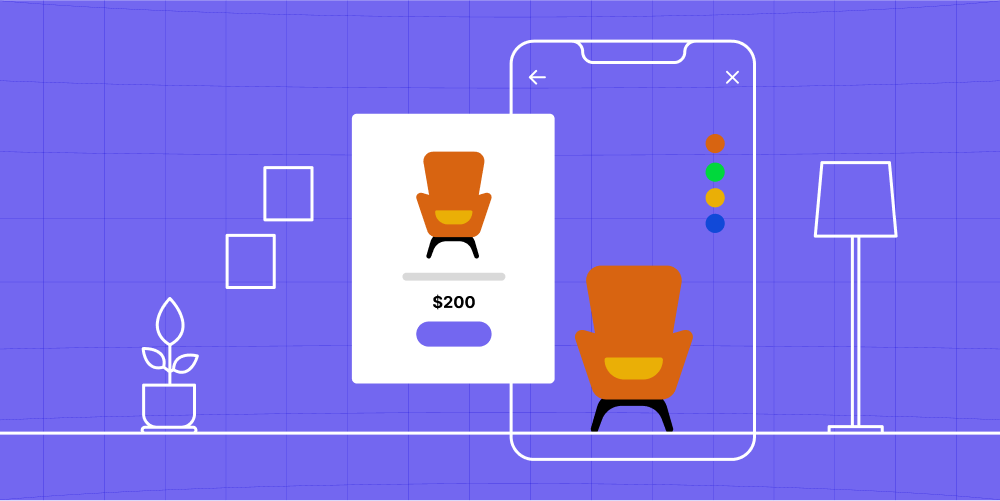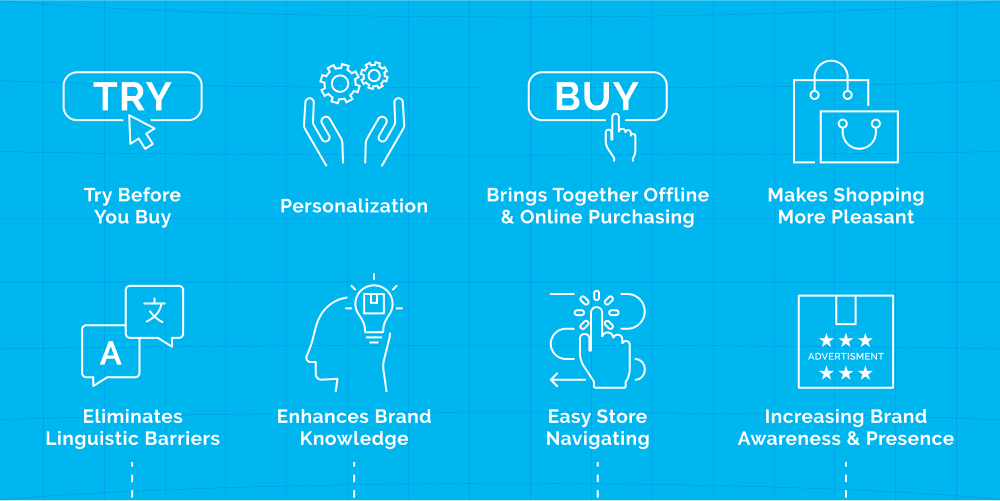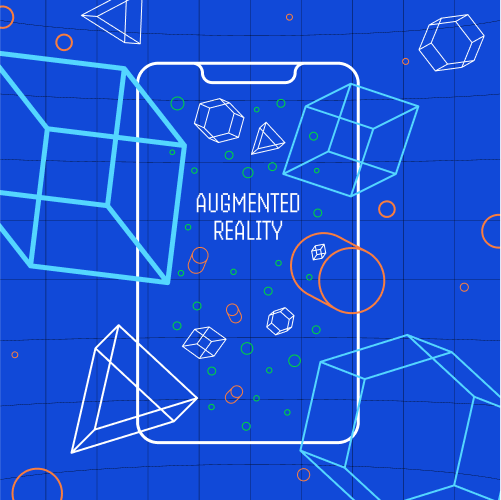CaptiveCoE™, zBlog
Role of Augmented Reality in Reshaping the Retail Industry
trantorindia | Updated: July 14, 2022

All things virtual have been turbocharged by Covid-19, propelling sectors like retail far into the future. The epidemic has sped up the transition to digital purchasing by about five years, according to a renowned global brand’s 2021 U.S. Retail Index assessment.
With the emergence of augmented reality (AR) applications, consumers may now virtually “try-before-you-buy” a plethora of products, from luxury clothing like Louis Vuitton and Gucci to daily items like furniture and home goods from IKEA and Home Depot. For shops, augmented reality has fast evolved from a nice-to-have feature to a need.
Around 810 million active mobile users make up the $30.7 billion augmented reality market, according to Statista. The smart AR glasses market itself is expected to reach 15.8 million units by 2027.
We could cite more figures, but one thing is sure: augmented reality (AR) and virtual reality (VR) are poised to fundamentally change how goods are sold online fundamentally.
What is augmented reality?

“Augmented reality,” or “AR,” refers to technology that enhances your world. In contrast to virtual reality, which immerses viewers in new virtual settings, augmented reality integrates digital content into your current environment.
An augmented reality application will incorporate visual, audio, and other sensory data into the environment to improve the experience. For instance, when you load your camera, your GPS app may display arrows on your phone’s screen to indicate which streets to turn down.
Due to its accessibility, AR has become one of the Emerging technologies with the fastest growth rates. Many modern customers currently carry a device in their pockets that they may use to access augmented reality.
Smartphones are the ideal AR platform due to their powerful processing capabilities and high-quality cameras. They aren’t the only method to experience augmentation, of course.
The innovators of augmented reality today are also starting to create AR spectacles, sometimes known as “smart glasses.” These provide more “hands-free” interactions, especially in an office setting.
Augmented Reality has quickly moved beyond just a tool for smartphone games to show its utility in various use cases, from helping surgeons with procedures to enabling engineers and mechanics to employ cutting-edge equipment in the field.
Augmented reality & Metaverse

Augmented reality has now moved to the next world with the addition of the Metaverse. The Metaverse and AR work well together. Although you can use them separately, they work best when used together.
Although you cannot alter the environment in which you now reside, augmented reality enables you to add a new dimension to your surroundings. You can enhance the environment you’re in your environment by using pictures, audio, texts, or even GPS information. These components must be presented spatially to influence how you perceive depth.
In line with market interest, the metaverse has already drawn in a set of core businesses, including Apple, Microsoft, Nvidia, and Roblox. Everyone is intended to build the infrastructure and facilities necessary to enable upcoming innovations. Read ahead to know how metaverse is helping retail and other businesses.
The shortcomings of the traditional retail industry

As technology advanced and the demand and supply for commodities increased, older marketing techniques needed to be updated. Retail establishments rose in size, more customers entered, and the system was better structured.
The following details emphasize the main problem.
- Limited Items: Items not in stock are a persistent issue with traditional retail businesses that you regularly deal with; you don’t know until you arrive. With little resources & widespread hoarding, the issue has multiplied fourfold in current times.
- Traveling: One prominent example is the pandemic’s recent effect on retail. There is always a risk of contracting an infected person during another lockdown phase when residents must stay indoors and only leave the house to obtain necessities.
- Cost of setup: Opening a physical retail location is usually expensive. It can entail SMEs risking everything they possess. Devoid of customers, firms suffer losses and must close their doors.
- Compartmentalization: Even when compartmentalization isn’t a problem, it can nonetheless be one. Keeping with the previous illustration, the longer you spend searching among different compartments for production, the more time you waste and the likelihood you’ll get sick.
- Limited business hours: Unlike internet buying, stores have set hours of operation. Policies have tightened up in tough times like this. You may not always have that much time to carefully search for and choose the item(s) you want to add to your cart.
Retail augmented reality: current state of affairs
Augmented reality is used in many ways by retailers. With the use of other gadgets like smartphones or tablets, this technology performs the overlaying of digital entities onto the surrounding environment.
The implementation of augmented reality has had a significant positive impact on the retail sector. AR in retail is another game regarding optimizing procedures and facilitating customer buying (both online and offline).
The key advantages of augmented reality in retail shopping that customers have widely noticed are listed below.
- Try Before You Buy: How nice is it to be able to try a product out while merely sitting in front of a digital gadget before buying it? That’s cool!It is the most engaging and intriguing way to use augmented reality in retail so customers can experience things before they buy. E-commerce companies should consider and implement this desirable feature on a flexible scale to increase client engagement and drive continuous sales growth.
- By building a 3D face model of the head and digitally recreating the spectacles in a photorealistic manner, Lenskart offers try-on capabilities that allow users to try on glasses. Customers can try various pairs of glasses on a 3D model and select the ones that best suit their facial features. It makes it less unclear how it will appear and encourages buyers to make purchases.
- Gucci released a mobile app that allows customers to try on any pair of footwear virtually. Here, you must aim the camera of the apparatus towards the foot for the sneaker to be rendered in three dimensions.
- Cosmetics stores can provide an application that lets their consumers test lipsticks, eye shadows, and other goods on their faces before purchasing, just like the Snapchat or Instagram filters.
- Customers could virtually install couches, tables, and other furniture at Ikea.
- Eliminates Linguistic Barriers: Even though so many languages are spoken worldwide, there are still certain obstacles, although they are only temporary. You can view any 40 foreign languages as your native tongue with Google Translate’s AR mode. Features of AR-based shopping apps channel language(s) in a way that either makes it region-specific or more accessible for you to grasp its offerings with the aid of AR and AI tools. Even if you use printed catalogs, the AR content will help you select the most convenient language.
- Personalization: Retailers frequently alter the material to better suit client expectations. You may have noticed that retail establishments filter out content for you so you can seek relevant things quickly. Many methods have been used to do this. Virtual reality (VR) technology is yet another tool used for improvement. They work together to offer complete AR VR retail solutions.
- Enhances Brand Knowledge: By incorporating AR technology into their operations, brands may offer more details about the product.
- Toyota used an augmented reality (AR) app to show their new hybrid vehicle’s operation to their consumers. It includes pictures of its internal workings to help users understand how the program functions. Additionally, add text or images to the product that the camera is pointing at for easier understanding.
- Brings Together Offline and Online Purchasing: Shopping is regarded as entertaining. Nowadays, shopping for the proper goods can be confusing due to the abundance of retail establishments and the large population. One of the significant advantages of augmented reality in e-commerce is that it mimics the same “fun” experience of conventional shopping techniques without inventory costs and endless queues.
- Easy Store Navigating: Finding items in large brick-and-mortar stores will be difficult because it takes time. This is easier to navigate through stores thanks to augmented reality applications. When you enter the store with a list of the items you want to buy, the app uses that list to identify the shelves and calculate the best route to get you all of them. Additionally, using digital arrows to guide would be helpful. Customers will find it easier to traverse the goods and avoid getting lost in other categories without spending several hours in the store.
- Customers can use Find My Way’s mobile app to find their way through stores. If you have a movie or event arranged, it also helps to locate your seats. It is intended to keep up with social estrangement caused by the COVID-19 epidemic and reduce contact with people as much as possible.
- Makes Shopping More Pleasant: One of the most significant AR/VR trends in contemporary retail is the accumulation of all the benefits. An online or offline merchant should offer the most interactive methods so that you have a worthwhile shopping experience and would choose to return to the shop/store/portal/app time and again. Digital/virtual mirrors are a significant component of the advanced in-store experience that is evolving.
- Increasing Brand Awareness and Presence: AR is an excellent tool for increasing a company’s brand exposure among more people. A company will be able to offer people unique experiences with the aid of mobile apps with cutting-edge AR features. Brands have a lot of leeways to develop inventive ways for interactions that create a tunnel for rapid response, thanks to augmented reality in-retailer marketing efforts.
AR & Metaverse: adding another feather to retail
Brands and retailers are hopping on the bandwagon in increasing numbers. The metaverse’s promise of seamless integration of shopping experiences throughout immersive digital environments is immensely alluring, but the technology needed to support it is still in its infancy. Metaverse is all set to change the way we shop retail products. L’Oreal, Adidas, & Martha Stewart have leaped into the metaverse world.
They are learning and increasing their awareness using the early metaverse. NFTs(nonfungible tokens) are being used by high-end labels like Burberry, Dolce & Gabbana, Hermes, and Gucci to generate buzz. The potential of retail in the metaverse is to improve the usability & engagement of online shopping. Online shopping would be more comparable to what customers can do in stores without ever leaving their homes if there was a tool that allowed them to explore and discover better than they do at the moment. If that were to occur, turning visitors into customers—which is currently far less effective online than in-store—would increase, making internet retail a much more lucrative & feasible business.
Future of augmented reality in retail
Although it is frequently asserted that augmented reality is a futuristic technology, this is untrue. All facets of the retail market have already used augmented reality (AR). It won’t be long before you’re shopping for everything you need while lounging on your sofa, enjoying a cup of coffee in the kitchen while sporting AR-enabled spectacles, or using augmented reality mobile apps. Yes, you can do all of this without ever leaving your house!
The obstacles in augmented reality e-commerce must also be addressed to reach a wider audience & keep current ones. A VR AR developer must pay particular attention to a few elements, whether using AR for physical or online commerce. Factors include advertising, localization, bonuses and discounts, individualized treatment, interaction, discovery, privacy, and UX.
A fascinating fact about retail is that, despite internet shopping and mobile commerce (M-commerce) gaining popularity daily, 71 percent of consumers (buyers in this example) prefer to experience virtual reality (VR) in a store rather than on their smart devices. Keeping people content in both realms is what augmented reality does.
Trantor’s AR game is going strong
We have worked with numerous businesses, SMEs, and brands in developing cutting-edge AR VR retail solutions at Trantor, a reputable AR VR development firm. We have been active in the Metaverse scene, and our technology experts are working way ahead to help businesses quickly turn to this new world of technology.
Excited? Our Retail AR experts await your call. Connect NOW.




